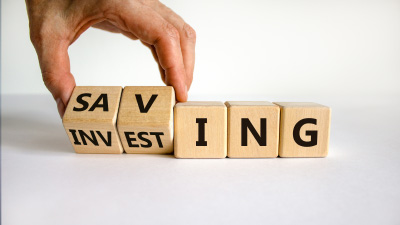Important
As your money is invested, the value of your investments can rise and fall, so you could get back less than you invest. Tax rules can change and the value of any tax benefits depends on your personal circumstances.
Different account types
Details of the accounts availableThere are currently four types of ISA available - cash ISAs, stocks and shares ISAs, lifetime ISAs and innovative finance ISAs. Each of these offers a tax-efficient way of saving so you don’t pay tax on any gains made or income received.
You can currently save up to £20,000 across all four of these ISAs every tax year. The amount you contribute each tax year must not exceed the annual allowance set by the UK Government (currently £20,000). The annual £20,000 allowance is subject to government change.
Saga offers the Saga Stocks and Shares ISA.
A stocks and shares ISA is a tax-efficient investment account which is offered by an ISA Manager, and approved by His Majesty’s Revenue & Customs (HMRC).
When you put your money into a stocks and shares ISA, your money is invested on your behalf in different types of investments such as funds, company shares (equities), bonds and cash. If these investments grow, so will your money. But there’s also a risk your money could go down in value and you may not get back the amount you invested.
All your investment returns are free of Capital Gains Tax and Income Tax, and you can take your money out at any time. You don’t need to declare ISAs on your Self-Assessment tax return as long as you stay within the annual ISA allowance (currently £20,000). The tax implications of ISAs and the relevant Government rules are subject to change.
The Saga Stocks & Shares ISA product is provided by Hubwise. It’s a ‘flexible ISA’, which means if you decide to withdraw some of the money you’ve invested in a particular tax year, you will be able to replace the amount(s) you’ve withdrawn in the same tax year. For example, if you pay £20,000 into the Saga Stocks & Shares ISA and then withdraw £10,000 in the same tax year, you’ll be able to invest a further £10,000 before the end of that tax year.
A GIA is similar to an ISA, but without its tax advantages. They’re useful if you’ve used up your ISA allowance and have more to invest. You can save as much as you like into a GIA and you can benefit from being invested across a wide range of investments.
When you put your money into a General Investment Account, your money is invested on your behalf in different types of investments such as funds, company shares (equities), bonds and cash. If these investments grow, so will your money. But there’s also a risk your money could go down in value and you may not get back the amount you invested.
You can take your money out at any time, but please be aware that you may need to pay Capital Gains Tax if your investments have increased in value when you sell them. You are currently able to make £3,000 in gains across all of your investments and on the sale of other assets, each tax year before you pay CGT. This allowance is subject to change by the UK Government.
Depending on your personal tax position, you may also need to pay income tax on any dividend income or interest received.
Because there are no tax benefits when investing in a GIA, you may need to declare any income or gains/losses on your Self-Assessment tax return.
The Saga General Investment Account product is provided by Hubwise.
Account management
Setting up and managing your Saga Investments accountIf you decide to make monthly payments into your Saga Investments product, you can set up a Direct Debit online when you’re applying for your product or at any other time by logging in to your online account.
Please note that regular contributions will be collected by direct debit on the 18th of each month, or the next business day if the 18th is a weekend or bank holiday. If your application is received within 10 working days of the collection date, the direct debit may not be processed until the following month. For example, if your application is received on 23 September, your first direct debit payment will be made on 18 October (or the next business day).
Electronic identity verification checks will be run during the application process. If these are passed, there’ll be no need for you to provide supporting documentation.
There may be situations where we can’t verify your identity digitally, for example if you've recently moved house. If this is the case, we'll contact you to request the supporting documentation, for example a copy of your passport or driving licence.
Not a problem. Just click on the ‘forgot password’ button on the login page and enter your email address, and you’ll receive a ‘reset password’ email.
You are not able to open a Saga Investments product on behalf of anyone else, or have a joint account with someone else.
No problem. You can provide notification that you have a LPA in place by logging into your online account or by contacting the Saga Investments team. Your LPA will then be able to get in touch on your behalf.
Saga Investments is provided jointly by HUB Financial Solutions Limited and Hubwise Securities Limited.
Saga markets the service to its customers and provides support to HUB Financial Solutions to ensure customers have ongoing access to relevant literature and information.
HUB Financial Solutions will act as your representative for Saga Investments. This means they’ll act on your behalf, and will be your first point of contact for queries or complaints about any part of the service. HUB Financial Solutions are also responsible for designing and maintaining the investment portfolios and Glide Path feature.
HUB Financial Solutions have arranged for Hubwise to provide and operate the investment platform and the Saga Stocks & Shares ISA and General Investment Account products. Hubwise also provide access to an online account for you to provide instructions, view your account holdings and transactions, and maintain your personal details.
HUB Financial Solutions Limited (FRN 455713) is authorised and regulated by the Financial Conduct Authority.
Hubwise Securities Limited (FRN 502619) is authorised and regulated by the Financial Conduct Authority, is an ISA Plan Manager (HMRC ISA Plan Manager Z1723) and a Member of the London Stock Exchange.
Saga is a registered trading name of Saga Personal Finance Limited. Authorised and regulated by the Financial Conduct Authority (FRN 178922).
At Saga Investments, we pride ourselves on our customer service and the culture we instil in all our staff. We aim to provide an individualised touch and positive experience for every customer regardless of their circumstances.
When setting up your Saga Investments product, you can flag any particular support needs you may have on the ‘Help us to support you’ screen. And if your needs change over time, you can log into your online account and tell us how we can best support you.
We understand that sometimes things don’t go as planned. If things do go wrong, we’re keen to quickly put them right. That’s why we value your feedback and treat all complaints seriously.
If you have a complaint about any aspect of the Saga Investments service, please contact HUB Financial Solutions by phoning 0800 302 9755, by emailing enquiries@sagainvestments.uk.com or in writing at Saga Investments, PO Box 13428, Chelmsford, CM99 2GJ. HUB Financial Solutions will liaise with Hubwise to ensure your complaint is appropriately addressed by the correct party.
If you’d like to complain directly to Hubwise about the investment platform or products, you can do so by emailing HW-Complaints@sscinc.com or in writing at Hubwise Securities Limited, Waverley Court, Wiltell Road, Lichfield, Staffordshire, WS14 9ET.
You can make one-off or regular withdrawals from your Saga Investments product. You can do this by logging in to your online account. Go to ‘Account options’ in the top right of the screen, and select ‘Withdrawals’. It may take up to five working days for you to receive your money. There is no charge for withdrawing your money.
Please remember that when you withdraw money from a Saga General Investment Account, whether as a one-off lump sum or regular withdrawals, you may pay Capital Gains Tax on any investment gains (depending on your personal tax position).
Your online account offers you easy access to your investments at any time. You have the flexibility to:
- Pay in more money – as a one-off or regular contribution
- Transfer the cash value of other investments to the Saga Stocks & Shares ISA or Saga General Investment Account
- Check the value of your Saga Stocks & Shares ISA or Saga General Investment account
- Run illustrations
- Request a transfer
- View your important documents
- Make a one-off withdrawal or set up regular withdrawals.
You can also perform the following by contacting the Saga Investments team by phone on 0800 302 9755:
- Turn the Glide Path feature on and off
- Changing your account details
- Switch Investment portfolio.
Understanding risks and choices
Making investing simpleSaga Investments is designed for people who are looking for a low-cost, simple solution to investing. Neither Saga, HUB Financial Solutions nor Hubwise Securities Limited will be able to offer any advice, recommendation or guidance on the products and investments offered by Saga Investments.
This means that, before you invest, you’ll need to be comfortable you understand the products and investment options available so that you can make your own decision on whether they’re appropriate for you.
If you need additional support to identify which products and investment portfolios will meet your needs, this is not the right service for you.
When you invest, your money is at risk. It’s important you’re comfortable with how much risk you’re taking. The value of your investments and any income received from them can fall as well as rise. This means you may not get back the amount you invested.
You can find information about the key risks to think about on our Things to bear in mind page.
No – the investment portfolios are not actively managed. Funds are not actively bought and sold to try to outperform investment markets.
Instead, the portfolios have been specifically designed to have a fixed asset allocation known as the ‘target fund mix’. With the exception of the ‘Federated Hermes Short-Term Sterling’ fund, the funds are all ‘passive funds’. This means they aim to track the performance of market indexes. HUB Financial Solutions will not seek to change any funds or the target fund mix as it does not undertake discretionary fund management.
HUB Financial Solutions will monitor the performance of each investment portfolio at least annually to ensure it is performing as intended and operating within the defined risk parameters.
In the unlikely event of the investment portfolio performing outside the defined risk parameters or not able to fulfil the investment objective, HUB Financial Solutions will contact you by email to notify you of the position so you can decide whether the investment portfolio remains appropriate for your needs.
A new investment portfolio may be added to the range which will act as an alternative option to meet the investment objective. It will be your decision whether to switch to that new investment portfolio. There would be no charge for switching.
Volatility is when an investment market goes up and down unpredictably.
Volatility can be caused by many things, for example global unrest and political uncertainty (such as elections or referendums).
Some investments are more volatile than others. For example shares (equities) are generally more volatile than bonds or cash. This means that investment portfolios which hold mainly shares are more volatile than portfolios that hold a large proportion of bonds and cash.
As with any investments the value of your investments and any income received from them can fall as well as rise. This means you may not get back the amount you invested.
The Saga investment portfolios are designed to have different levels of volatility:
• ‘Lower volatility’ - The Cautious Growth Portfolio is designed to have lower volatility. This means that, although it will go up and down in value, the peaks and troughs won’t be as high as with more volatile portfolios. But this also means there’s lower potential for long term growth.
• ‘Medium volatility’ – The Balanced Growth Portfolio is designed to have medium volatility. This means there’s some chance of higher ups and downs. But there’s also more growth potential than with a less volatile portfolio.
• ‘Higher volatility’ - The Adventurous Growth Portfolio is designed to have higher volatility. This means it will go up and down in value, and the ups and downs will be higher and lower than with less volatile portfolios. But there’s also higher potential for long term growth.
When choosing your investment portfolio, it’s important to ask yourself how you feel about the thought of your money going up and down in value.
Not really. Choosing a ‘lower volatility’ portfolio won’t change the likelihood and frequency of ups and downs. It just changes how much it’ll go up and down.
Find out more about volatility and how it might affect your Saga investment portfolio.
Investing with ESG factors in mind means actively excluding businesses that don’t adhere to key environmental, social and governance principles. There are lots of reasons why a company might be excluded – from certain types of product such as tobacco companies, to operations with a heavy reliance on fossil fuels.
The Saga investment portfolios don’t offer funds that adhere to ESG factors. That’s because – to help keep costs low - the funds track market indexes (such as the FTSE 100). The fund managers have no control over the companies that form part of that index, so they’re not able to exclude investments based on ESG criteria.
If this is important to you, Saga Investments will not be appropriate for your needs.
It is necessary to hold some cash in your Saga Investments product. This is to cover any fees that will be due and allow enough cash to cover any regular withdrawals you have requested. Each Saga Investments product therefore has a ‘Cash Account’.
When you first pay money in to your product, it will go into the Cash Account. Before your money can be invested into the funds, a ‘Buying Power’ calculation takes place to work out how much of the cash should be held back to cover fees and regular withdrawals for the next three months. The rest of your money is then automatically invested into the mix of funds set by your chosen investment portfolio.
To make sure you always have enough cash available, this calculation is repeated every time you make a contribution, a withdrawal or your portfolio is rebalanced. When you make a one-off withdrawal, it will use any available cash before selling funds to raise the cash required.
Some of the funds held in your Saga Investments product pay income as cash. This is credited to your Cash Account and will be invested if not required to cover fees or withdrawals.
Any cash held in your Cash Account will earn interest. This is calculated daily and applied half yearly in June and December.
For more information about the Cash Account, please see the Saga Investments Terms & Conditions.
When you set up a Saga Investments product, you appoint Hubwise to act as custodian of your assets. Your assets are held separately from Hubwise’s business assets in a pooled account with other customers of Hubwise. Hubwise maintain full records of your individual assets so even if the worst happened and Hubwise went into administration their creditors would not have a claim on your assets (money).
In the unlikely event of this happening, you may be entitled to compensation from the Financial Services Compensation Scheme (FSCS) up to a maximum value of £120,000.
HUB Financial Solutions, Hubwise and the providers of the funds you hold within your Saga Stocks & Shares ISA and Saga General Investment Account are covered by the Financial Services Compensation Scheme (FSCS). This protects customers against financial services firms that have failed.
In the unlikely event that any of these companies can’t meet their obligations, you may be entitled to compensation from the scheme up to a maximum limit of £120,000 per person, per firm.
The FSCS does not cover losses for poor investment performance - the nature of investments means their value can go down as well as up.
For more information, visit the FSCS website.
Saga Investment fees and charges
Details around all the fees and charges you should expectThe total annual cost of the Saga Investments products is up to 0.75% per year of the overall value held within the product(s). So, if your ISA/GIA had a value of £10,000, the total cost for the whole year would be up to £75. This total cost of 0.75% is made up of product fees (which are deducted from the product) and fund charges (which are reflected in the value of your funds). There are also fund transaction costs, which are not included in the 0.75% figure.
The amount you actually pay will increase and decrease in line with the value of your products, and additional fund transaction costs will apply. Further information about the fees and charges is provided below.
There is no up-front fee for investing in the products, and no exit fee when you take your money out.
Product fees
The fees are 0.65% per year based on the value of your ISA/GIA. So, if your ISA/GIA had a value of £10,000, the fees for the whole year would be £65.
The 0.65% is made up of:
• An Investment Service Fee of 0.52% per year – paid to HUB Financial Solutions for providing ongoing support to you in relation to Saga Investments.
• A Platform Fee of 0.13% per year – paid to Hubwise for acting as custodian of your assets and providing the platform services and investment products.
These fees are automatically calculated and accrued daily. They are deducted on the first working day of each month from the cash account within your Saga investment product(s). After the fees have been deducted, you will see this on your statement.
Fund charges and costs
There are also charges and costs which apply to the individual funds you hold. You don’t pay these directly – they are reflected in the value of your funds and so impact the funds’ performance. There are two main types:
• Fund charges - levied by the fund management companies for operating and managing the funds in your investment portfolio. The fund charges vary by fund, so the total amount will depend on the target fund mix of the portfolio you have chosen. The total fund charges will be up to 0.10% per year for the whole portfolio, so if your ISA/GIA had a value of £10,000, the annual fund charges for the whole portfolio would be up to £10. The fund charges are included in the 0.75% figure quoted above.
• Fund transaction costs – incurred by each fund when it buys and sells the underlying assets it holds, such as equities and bonds. The level of these costs depends upon the dealing activity in the fund, so it’s not possible to accurately predict them in advance. For this reason, they are not included in the 0.75% figure quoted above. Based on past dealing activity, they will typically be up to 0.04% per year in total for the target fund mix of the Saga investment portfolios.
Other charges
Finally, there may be occasions when Hubwise will need to apply other charges. This will only happen in circumstances when additional actions are necessary to service your Saga Investments products. For example, as this is an online service where you can access all your account documents, should you ask for paper copies of the documents there may be a charge for this.
For more information
Full details about all fees and charges, and examples of how they’re calculated and collected, are available in the Saga Investments Terms & Conditions and the Schedule of Charges. You’ll receive a full up-front breakdown of the fees and charges you’ll pay in the ‘Illustration of Costs and Charges’ document when you open a product.
Fund transaction costs are incurred by each fund in the Saga investment portfolios when it buys and sells the underlying assets it holds, such as equities and bonds.
The level of these costs depends upon the dealing activity in the fund, so it’s not possible to accurately predict them in advance. For this reason, they are not included in the 0.75% total cost figure.
Based on past dealing activity, they will typically be up to 0.04% per year in total for the target fund mix of the Saga investment portfolios.
We understand that ‘up to 0.10%’ doesn’t make it totally clear what fund charges you’ll pay each year. But 0.10% is the most you will pay for fund charges.
Unfortunately, it’s not possible to provide an exact fund charges amount. This is because each of the funds in the Saga investment portfolios has a different charge. So the total fund charges amount will depend on the portfolio you select and how much you’ve got invested in each fund. And this can go up and down slightly from day to day depending on the performance of each fund.
If your investments were to stay invested in line with the target fund mix for the Saga investment portfolio you’ve selected, you would actually pay between 0.08% and 0.09% (depending on the portfolio). The total fund charge will vary slightly from this. We therefore quote ‘up to 0.10%’ to ensure we’re not under-stating the charges.
How investing with Saga Investments works
What you're able to invest in, how long it takes, and what features are availableWhen you invest in a Saga Investments product, you have a choice of three ready-made investment portfolios. Each portfolio comes with a different investment objective and level of risk.
You just need to choose the one that’s best aligned to your individual circumstances and goals.
Investment portfolios and funds
Before we explain how it works, there are a couple of terms you should be aware of:
• Investment portfolio – This is an investment strategy designed by HUB Financial Solutions for Saga Investments. It determines the mix of funds your money will be invested in. Each investment portfolio is made up of a mix of funds which enables you to invest in a wide range of different assets like cash, bonds and company shares (or ‘equities’).
• Fund – This is an investment product that is offered by a fund management company. It is designed to invest in different assets based on a set investment objective. Each fund can be focused on different stock markets and asset types. For example, a UK Equity Fund will invest in a range of different companies in the UK, buying shares in those companies. There are hundreds of funds offered by many fund management companies.
The Saga investment portfolios
Rather than provide you with a large range of funds which you need to research and choose from, Saga Investments offers a selection of three ready-made investment portfolios designed by HUB Financial Solutions with Saga customers in mind.
Each portfolio comes with a different investment objective and level of risk. You just need to choose the one that’s best aligned to your personal circumstances and goals.
Once you’ve chosen your investment portfolio, the money you’re putting into your Saga Investments product is invested into the mix of funds determined by the investment portfolio.
It’s as simple as that. All you then need to do is review your investment portfolio to make sure it’s still appropriate for your needs. It’s up to you how frequently you do this, but it’s suggested you do this at least once a year.
For more information about each of the investment portfolios, please see the investment portfolio fact sheets. These tell you the objective of each portfolio, the expected level of risk, the mix of funds you will invest in and historic performance data.
If you’d like more information on the individual funds, please see the Key Investor Information Documents (KIIDs) on our Important information page.
The income produced by the funds you hold in your Saga Investments product will be credited to the product’s cash account and automatically reinvested the next time your portfolio is rebalanced, a further contribution is made or the 22nd of each month, whichever is earlier.
You can find the fund mix for each investment portfolio in the portfolio fact sheets (under ‘Target fund mix’).
Yes you can. For example, if you choose the Adventurous Growth Portfolio when you first apply, but later decide that the Balanced Growth Portfolio is better suited to your needs, you can arrange a switch. You can do this by phoning the Saga Investments Team on 0800 302 9755. There is no charge for switching.
When switching, some of the fund holdings within your product will be sold and the proceeds will be reinvested to ensure your fund holdings are aligned with the target fund mix of the new investment portfolio. Once the switch has been completed, you will be able to view the new holdings and confirm the deals via your online account.
Because some of your investments will be sold and reinvested, some of your money won’t be invested in the market during the switching period (up to five working days). You may lose out on income and capital growth during this time. Depending on market movements, the cost of investing in the new funds will have changed up or down.
Also, if you’re invested in the Saga General Investment Account there may be tax implications. Please see the ‘Things to bear in mind’ page for more details.
It's important to bear in mind that the investment portfolios are designed to support your investment objectives over the medium to long term (at least five years). They are not designed for you to select a different investment portfolio for tactical, short-term reasons.
You can only invest in one portfolio per product, so you can’t put £10,000 into the Balanced Growth Portfolio and £10,000 into the Adventurous Growth Portfolio in the same Saga Stocks & Shares ISA or in the same Saga General Investment Account.
The value of your investments and any income received from them can fall as well as rise. This means you may not get back the amount you invested. If you’re investing for something specific over the longer term, and you plan to switch to a lower risk investment portfolio at some point in the future, you may want to consider the Glide Path feature, which could help meet your needs.
You can find out more about the Glide Path on our Saga investment portfolios page.
No, you can select a different investment portfolio for your ISA and GIA. For example, you could choose the Balanced Growth Portfolio for your ISA and the Cautious Growth Portfolio for your GIA. Or you can choose to have the same portfolio for both the ISA and GIA. It’s up to you, and you can change your choice at any point.
When you pay into a Saga Investments product, it can take up to five working days for your money to be invested.
You can choose the Glide Path feature when you first invest. You just select ‘Choose a Glide Path’ and then tell us which level of risk you want to start with.
You can also switch the Glide Path feature on and off at any time after you’ve invested by logging in to your online account.
Absolutely. You’ll receive an email confirming details of the upcoming switch. This will give you the opportunity to turn off the Glide Path feature if you no longer want the switch to take place.
It is possible that one of the funds in the Saga investment portfolios may be suspended if the market it tracks is suspended. This only happens in unusual circumstances, for example in times of economic crisis. If a fund is suspended, it is not possible to buy and sell units in that fund.
Markets are also closed on public holidays. For example, the Shanghai Stock Exchange closes each year in late September/early October for the Chinese Mid-Autumn Festival and China’s National Day. The Saga Investments portfolios’ quarterly rebalancing has been scheduled for 10 October to ensure it doesn’t coincide with this.
When you open a Saga Investments product, the way your money’s invested will depend on the investment portfolio you have selected.
Each investment portfolio sets a mix of funds that’s designed to achieve a specific investment objective and provide a particular level of risk. This is known as the ‘target fund mix'.
When you’ve chosen your investment portfolio, your money will be invested based on this target fund mix.
Over time each individual fund held will rise or fall in value differently based on the underlying investments it holds. This means the mix of funds in your portfolio will differ slightly from the target fund mix and the overall risk profile of your investments would be higher or lower than the portfolio’s set level of risk. This might mean your portfolio is at risk of greater losses if investment markets were to fall or you may or not achieve as much growth as expected.
To ensure this difference doesn’t become significant, your portfolio will be ‘rebalanced’ every three months.
Find out more about how rebalancing works.
The rebalance process will happen automatically every three months, on 10 January, 10 April, 10 July and 10 October each year. Where this falls on a weekend or bank holiday, it will be scheduled to occur on the next day funds are available to deal (normally the next working day).
If one or more of the funds is not able to be traded on the day of a rebalance because of a fund suspension, the money will be apportioned across the funds that can be traded leaving the fund(s) not traded untouched until the next rebalance. In the event this happens HUB Financial Solutions will notify you.
Tax and ISA allowances
How investing works and how it can affect allowancesSaga Investments makes it easy for you to transfer the cash value of investments you have with other providers - whether that’s ISAs, other investment accounts or both.
Please be aware that when you’re transferring investments you hold elsewhere, your existing provider will sell your investments and transfer the proceeds as cash to be reinvested. This means that you may lose out on income and capital growth while your money is not invested in the market during the transfer.
It’s not possible to say exactly how long you will be out of the market. This depends partly on the provider you’re transferring from. Your money will be invested within five working days once it’s received by Hubwise). So if it takes your provider five working days to sell your investments and transfer the cash, your money will not be invested for up to 10 working days in total. Depending on market movements, the cost of investing in the new funds will have changed up or down during this time.
Make sure you check your existing investments for exit fees or other penalties, and ensure you’re not missing out on any investment benefits or bonuses by transferring your investments across.
You can transfer the cash value of any existing ISAs you hold with other providers. Transfers from previous tax years won’t affect your allowance for this tax year. If you are transferring an ISA from another provider - you can transfer a partial amount, or the whole amount, but any money you have paid into it in the current tax year will still count toward your £20,000 annual allowance.
If you invest in a Saga Stocks & Shares ISA, you won’t have to pay any tax on investment growth or regular withdrawals. If you've not already invested, or you've still got some of your annual ISA allowance left in the current tax year then the Saga Stocks and Shares ISA (provided by Hubwise) might be right for you.
You don’t need to declare ISAs on your Self-Assessment tax return.
With a Saga General Investment Account, you may need to pay Capital Gains Tax on your investment growth. You can currently make £3,000 in gains across all of your investments and on the sale of other assets, each tax year before you pay CGT. This allowance could be subject to change by the Government. You may also need to pay Income Tax on any regular withdrawals depending on your personal tax position.
Because there are no tax benefits when investing in a General Investment Account, you may need to declare any dividend income or interest received and any realised investment gains or losses on your Self-Assessment tax return, depending on your personal circumstances.
This should not be taken as tax advice. If you’re uncertain about the tax implications of investing in a Saga General Investment Account, it is recommended you speak to a professional tax adviser. Tax depends on your personal tax position. Tax rules are subject to change by the UK Government.
Limits and restrictions
Some things you need to be aware ofYou can open a Saga Stocks & Shares ISA with a minimum lump sum investment of £100 or a minimum monthly payment of £100. (Providing you've still got some of your annual ISA allowance left in the current tax year.)
You can transfer an ISA from another provider - either a partial amount, or the whole amount, but any money you have paid into it in the current tax year will still count toward your £20,000 annual allowance.
You can pay up to £20,000 into stocks and shares ISA's during a tax year.
You’re free to pay into different types of ISAs in the same tax year, but the total amount you put in can never add up to more than £20,000 in any tax year across all ISA products held.
The £20,000 limit is subject to change by the Government.
You can transfer an ISA from another provider - either a partial amount, or the whole amount, but any money you have paid into it in the current tax year will still count toward your £20,000 annual allowance.
You can open a Saga General Investment Account (provided by Hubwise) with a minimum lump sum investment of £100 or a minimum monthly payment of £100.
Or you can transfer all or part of the value of any investments you hold with other providers into the Saga General Investment Account.
You can save as much as you like in a General Investment Account.
Life events
When something unexpected happens we're here for youIf you die, your ISA will continue until:
• it’s closed by your executors or personal representatives
• your estate administration finishes, or
• the third anniversary of the date of your death.
Your executors or personal representatives will be contacted about the options available:
• If the ISA continues while the estate is being administered, no further contributions will be allowed into the ISA. But the money will still have the opportunity to grow – and remain free of Income Tax and Capital Gains Tax – until the end date. Please note that the value of the investment can also go down.
• Your spouse or civil partner can transfer the ISA to their name. This doesn’t impact their ISA allowance and your ISA will not form part of your estate for Inheritance Tax (IHT) purposes.
• However, your executors or personal representatives can’t request the transfer of the ISA to an alternative ISA manager. If your ISA is left to someone other than your spouse or civil partner, it will form part of your estate and may therefore be subject to Inheritance Tax (IHT).
Until your personal representative has been appointed, the portfolio rebalancing will not take place.
If your ISA isn’t closed, or your estate isn’t finalised within three years and one day from your date of death, your ISA will lose its tax-efficient status and effectively become a GIA. All income received or investment gains made after that point will become taxable.
If your spouse or civil partner dies, you can transfer their ISA(s) over to a Saga Stocks & Shares ISA in your name within three years of the date of their death.
Your Saga General Investment Account will continue until:
• it’s closed by your executor
• your estate administration finishes.
The money you hold in your Saga General Investment Account will form part of your estate and may therefore be subject to Inheritance Tax (IHT).
The information provided on this website should not be taken as a recommendation, advice or forecast. Tax depends on your personal tax position. Tax rules are subject to change by the UK Government
More from Saga Investments
Saga help you explore investing









